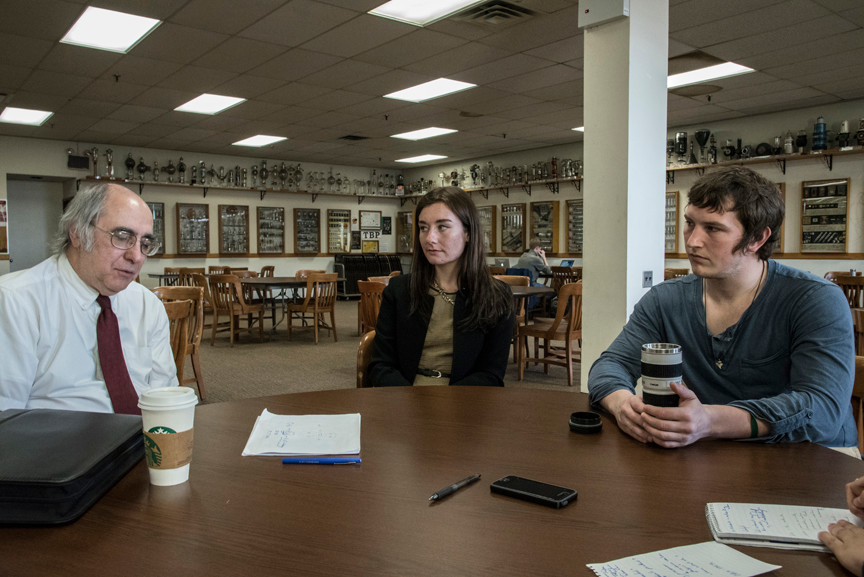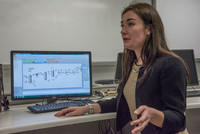Young engineers in spotlight
Two engineering graduate students from Manhattan College recently came back from a very unusual field trip: a visit to the Idaho National Laboratory.
But Eugene Heerschap and Olivia Mason didn’t just get a tour of the enormous federal complex, which houses the nation’s lead laboratory for nuclear energy research, among other research units. Last week, the students got the chance to present their research on ways to bring the global carbon footprint down and potentially revolutionize the petrochemical industry.
Mr. Heerschap and Ms. Mason, along with fellow graduate student Sebastian Garcia, have all been working with Manhattan College professor Gennaro Maffia and Anne Gaffney, a senior fellow at Idaho National Labs, researching how to make the petroleum refining process both environmentally and economically friendly.
“They [the Idaho National Labs] were very impressed with the work and said we actually need to get this patent pushed for the three of us as inventors,” Ms. Mason said.
Under the guidance of both their professor and Ms. Gaffney, the students have been looking at ways to create a process called the oxidative dehydrogenation of ethane, or ODH, and make it commercially viable. Ethane is a component of natural gas that becomes a pollutant when combusted. By applying ODH to ethane, it creates ethalyn, which is a much cleaner gas. The result could be a significant reduction of the carbon footprint.
“It looks very promising,” Mr. Heerschap said.
“By designing this ODH plan, we’re able to lower the carbon footprint by 30 percent, and that’s us being very conservative,” Ms. Mason said. “Going after the largest petrochemical, you can really make an impact and I think that’s what really attracts me to this project and I feel honored to be a part of it.”
By the year 2020, this will have the ability to make an environment-friendly petrochemical process that produces water and energy, according to Mr. Maffia.
“[The incentive is that] the current technology is very environmentally unfriendly, it’s very energy-intensive and very raw material-intensive,” he said.
Recently, their work gained extra visibility when Ms. Gaffney presented it on the floor of the U.S. Senate.
One of Mr. Maffia’s former colleagues on the Alaskan Pipeline Project, Ms. Gaffney had originally reached out to him asking for help in process development.
Mr. Maffia said that’s when he decided to call on his “experts” — the students.
Mr. Maffia launched a class devoted to ODH in the fall 2015 semester. About 17 students enrolled and have been working on advancing this research since.
Students have been working out of the college labs in Leo Hall, using a computer modeling software called ASPEN-HYSIS. “It’s like SimCity, but instead you’re building a chemical plant,” Mr. Heerschap said, referring to the computer game that allows users to build houses and communities.
“That’s our way of doing things and learning without going out and building,” Mr. Maffia said. But that’s only the first step, he added. “We’re suggesting that they run some experiments.”
Using this software, Mr. Heerschap made a potentially world-changing discovery. When oil is produced, so is a large amount of gas, including ethane. The current way of dealing with that gas is to flare it, which means taking the gas and combusting it, which also creates the greenhouse gas carbon dioxide, and then letting it spill into the atmosphere.
“Eugene has discovered that we can actually cool that stuff down to the point of making most of it a liquid, sending that in a pipeline and the part that’s not made into a liquid to be used as fuel to make the other stuff into a liquid. So it closes the loop on the whole process, it doesn’t involve any flaring, or venting or any of that jazz and it’s a major discovery,” Mr. Maffia said.
But he added that they do not trust ASPEN-HYSIS to the point of saying that this is breakthrough technology. “Maybe, but we need to do experiments first. And I think the Idaho Lab is best equipped to do those experiments with students like these guys helping them.”
Mr. Maffia is proud of the students’ work and the students feel lucky to be part of the project.
“The chemists at the Idaho National Labs were taking what we’re saying into consideration because we were trained by ‘the boss’, “ Ms. Mason said in a smile.
“We’re very fortunate to be working with Dr. Maffia, he has so much industry experience and so much knowledge we can feed off,” Mr. Heerschap added.









